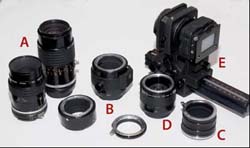articles/Lens/marvellousmacro-page2
Marvellous Macro - part 2 of 1 2 3 4 5 6 7 8 9
by Mike McNamee Published 01/04/2007

Lens Extension
There are four ways of creating lens extension
1. [A] Via the focusing mechanism of the lens, sometimes with additional internal lens movements to betteroptimise aberrations. In general modern, aspheric lens technology has enabled more ambitious magnifications to be provided. Almost all of today's macro lenses can achieve 1:1, compared to only 1:2, twenty years ago.
2. [B] Using Extension tubes. These are sized specifically for an individual lens or, sometimes [C], are mixed size sets so that the changes can be rung.
3. [E] Using a bellows extension. Only Nikon currently have bellows in their catalogue. Bellows allow for the largest magnifications as well as the use (with adaptors) of specialist micro lenses and the use of enlarging lenses. They are cumbersome to use and disconnect the electronic signalling between lens and body.

4. [D] A teleconverter. This increases the effective focal length of the prime lens and a 2x converter doubles both the working distance and maximum magnification of the prime lens alone, at the cost of a 2-stop loss in aperture (which is usually not an issue as you are striving to get to f16 anyway!).
All of these methods create more magnification than that which is achievable with the prime lens alone. Changing the rotating focus barrel of the lens (or auto focusing) changes the magnification and for scientific work, in which a known value is important, it is usual to focus by moving the whole camera back and forth until the subject is sharp. For critical, higher magnification shots, a focusing rack is invaluable, as it allows for precise movement of the camera. The alternative is to keep the camera fixed and move the subject, sometimes by means of a scissor jack or some other mechanical device. Quality scissor jacks can cost as much as a digital SLR!
Please Note:
There is more than one page for this Article.
You are currently on page 2
- Marvellous Macro page 1
- Marvellous Macro page 2
- Marvellous Macro page 3
- Marvellous Macro page 4
- Marvellous Macro page 5
- Marvellous Macro page 6
- Marvellous Macro page 7
- Marvellous Macro page 8
- Marvellous Macro page 9
1st Published 01/04/2007
last update 09/12/2022 14:56:30
More Lens Articles
There are 0 days to get ready for The Society of Photographers Convention and Trade Show at The Novotel London West, Hammersmith ...
which starts on Wednesday 15th January 2025





